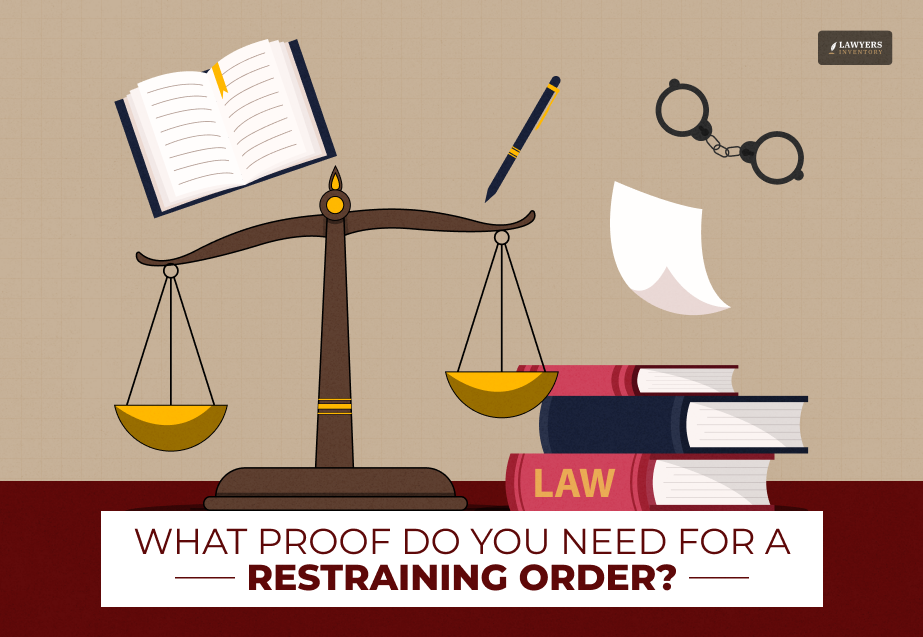
When you feel unsafe due to someone’s behavior, filing for a restraining order can be a vital step to protect yourself. But before you proceed, it’s essential to understand what kind of proof the court requires. Without the proper evidence, your request may not be granted.
A restraining order is a legal tool to prevent harassment, abuse, or threats. However, the burden of proof lies on you to show the court why you need protection.
This means you must provide clear, compelling evidence that supports your case. Examples could include text messages, emails, witness statements, photos of injuries, or police reports.
The key is to demonstrate a pattern of behavior or a specific incident that poses a real threat to your safety. Courts take these cases seriously.
Still, they also require concrete proof to ensure fairness. If you’re unsure about what qualifies as evidence, you need clarification from professionals who can help you prepare a stronger case.
This article will walk you through the types of proof you may need, helping you feel more confident about the process. So, keep reading this till the end, and thank me later!
Understanding Restraining Orders
A restraining or protection order is a legal document issued by a court to safeguard someone from threats, harassment, or abuse.
It’s often sought by individuals facing domestic violence, stalking, or situations where their safety is at risk.
By legally restricting the person’s behavior posing a threat, restraining orders can provide a sense of security and peace of mind.
However, getting a restraining order isn’t as simple as filing a form. Courts require evidence to justify issuing one, which means you must demonstrate the need for protection.
Types of Restraining Orders
Restraining orders come in various forms, depending on the situation. Here are the most common types:
- Domestic Violence Restraining Order: This is the most common type and is often used to protect victims of abuse by someone they share a close relationship with, such as a spouse, partner, family member, or cohabitant.
- Civil Harassment Restraining Order: If the harassment comes from someone you’re not closely related to—such as a neighbor, coworker, or acquaintance—you may file for this type of order.
- Workplace Violence Restraining Order: Employers can use this order to protect their employees from threats, harassment, or violence in the workplace.
- Elder or Dependent Adult Abuse Restraining Order: This type of order protects vulnerable individuals, such as seniors or dependent adults, from abuse, neglect, or exploitation.
Each type of restraining order serves a specific purpose, so it’s important to determine which one applies to your situation before you file.
Laws for Restraining Orders are Different in Different States
It’s essential to understand that restraining order laws vary significantly from state to state in the U.S. While the general process may seem similar, the specific rules, forms, and requirements depend on where you live.
For instance, in California, victims of domestic violence can seek an immediate temporary restraining order (TRO) that lasts until the court hearing, typically within 21 days.
On the other hand, states like Texas may require additional evidence or a slightly different process for obtaining the same protection.
Additionally, the definition of abuse or harassment may differ across states. Some states may include financial abuse or online harassment as grounds for a restraining order, while others may not.
This is why it’s crucial to research your state’s specific laws or consult a legal expert to ensure you meet all the requirements.
Understanding these differences can make the process smoother and improve your chances of success. Local courts often provide free resources or legal assistance to guide individuals through the process, which can be especially helpful if navigating this for the first time.
What Proof Do You Need for a Restraining Order
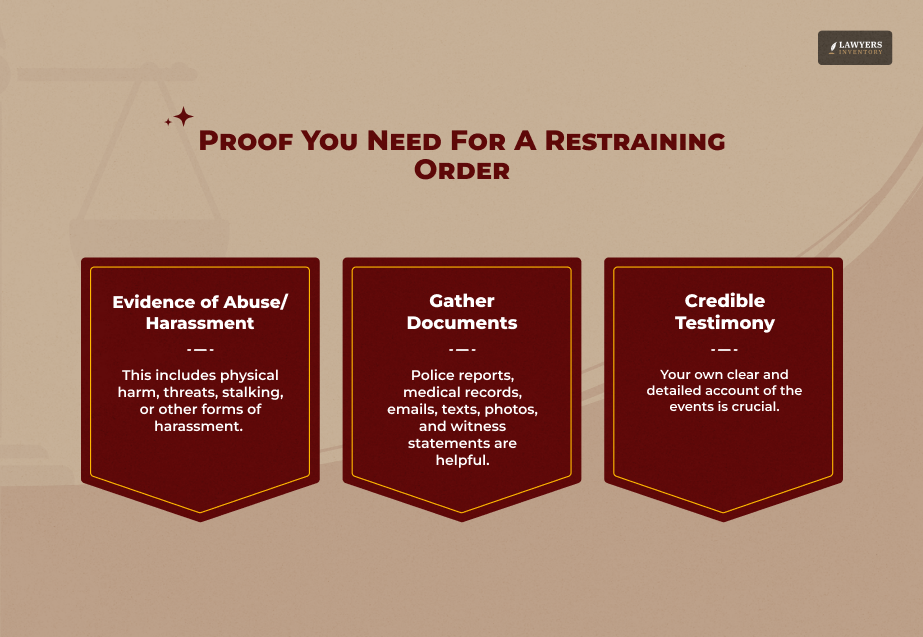
If you’re considering filing for a restraining order, you’ll need to present solid proof to the court. Judges don’t issue restraining orders lightly—they need clear evidence to understand the situation and ensure the order is justified. So, what kind of proof will you need?
First, document everything. Written records are incredibly valuable. This could include threatening text messages, emails, or social media posts.
If there were physical incidents, take photographs of any injuries or property damage. Police reports are another critical piece of evidence. Their report can support your case if law enforcement is called to your home.
Witness statements can also strengthen your claim. If friends, neighbors, or coworkers saw the abuse or harassment, their accounts can corroborate your story. Medical records like doctor’s injury reports can further validate your claims.
The court looks for evidence that paints a clear picture of a pattern of abuse, harassment, or threats. Small details, like a journal documenting incidents, can help build your case. Ultimately, the stronger your proof, the more likely the court will grant the restraining order.
How Long Does a Restraining Order Last?
The duration of a restraining order depends on the type of order issued. Temporary restraining orders (TROs) are usually short-term, lasting from days to weeks. These are designed to provide immediate protection until a court hearing occurs.
Once the hearing occurs, the judge will decide whether to grant a permanent restraining order. Despite the name, these orders aren’t truly “permanent.” In most states, they typically last between one and five years, though some can be renewed indefinitely.
Emergency restraining orders, issued in urgent situations when the court is closed, often expire within a few days. You must follow up by requesting a longer-term order during regular court hours.
The length of the restraining order will also depend on the severity of the situation. In cases of extreme danger, courts may issue longer orders to ensure continued protection.
Do You Have to Renew a Restraining Order?
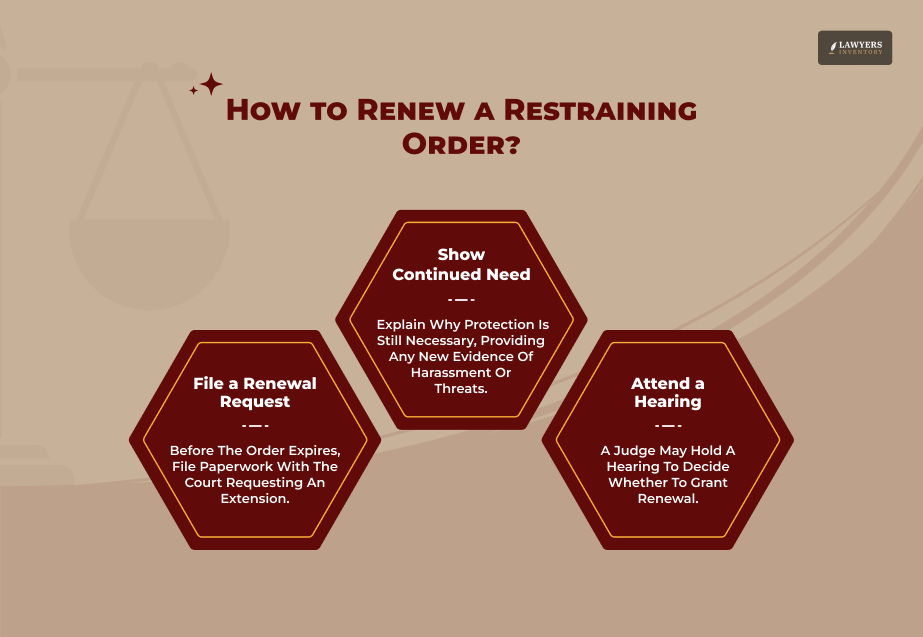
Yes, in most cases, you’ll need to renew a restraining order if you still require protection after it expires. The renewal process varies by state but generally involves filing a request with the court before the order’s expiration date.
When renewing, you must explain why the restraining order is still necessary. This could involve showing that the person’s threatening or harmful behavior hasn’t stopped or that you still feel a risk to your safety. You might also provide updated evidence, such as recent incidents, to support your case.
It’s important to act early. Waiting too long could leave you unprotected if the order expires before processing your renewal request. Many states offer simplified forms and guidance for the renewal process. If you’re unsure how to proceed, consider consulting with an attorney to ensure your safety.
How to File a Restraining Order?
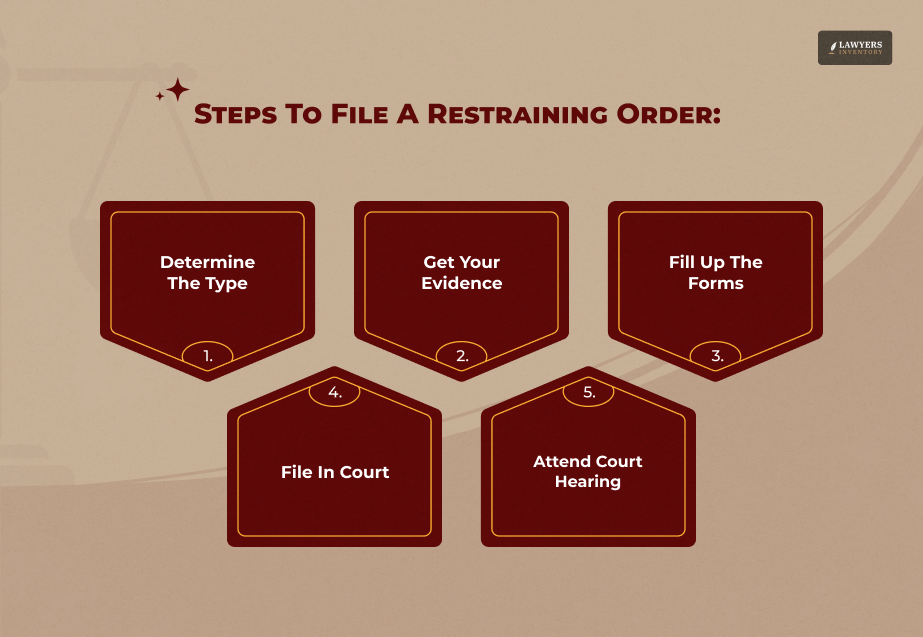
Filing a restraining order might feel overwhelming, especially if you’re dealing with a stressful or unsafe situation. However, the process is straightforward when broken into clear steps. Here’s a step-by-step guide to help you understand how to file a restraining order and ensure your safety.
Determine the Right Type of Restraining Order
The first step is determining which type of restraining order applies to your situation. Different circumstances require different orders:
- Domestic Violence Restraining Order for cases involving close relationships like a spouse, partner, or family member.
- Civil Harassment Restraining Order for harassment by someone not closely related, like a neighbor or coworker.
- Workplace Violence Restraining Order if threats or harassment occur at work.
- Elder or Dependent Adult Abuse Restraining Order to protect vulnerable individuals.
Knowing the correct type ensures you file the appropriate forms and provide the required evidence.
Gather Evidence
Courts require proof to issue a restraining order, so collecting evidence is crucial. This includes:
- Text messages, emails, or social media posts showing threats or harassment.
- Photos or videos of injuries or property damage.
- Police report if law enforcement was involved.
- Witness statements from friends, neighbors, or coworkers who observed incidents.
Organize your evidence clearly to make it easy for the court to review.
Obtain and Complete the Required Forms
Visit your local courthouse or their website to get the necessary restraining order forms. These forms typically include:
- A petition detailing your relationship with the individual and the nature of the abuse or harassment.
- A request for temporary protection if you need immediate safety.
Fill out the forms carefully, providing as much detail as possible. If you’re unsure about any section, you can ask the court clerk or a legal aid professional for help.
File the Forms with the Court
Once you’ve completed the forms, submit them to the courthouse in your area. In many cases, there’s no filing fee for restraining orders related to domestic violence or harassment.
After filing, the court will provide a date for a hearing, and a temporary restraining order (TRO) may be issued to protect you until the hearing.
The person you’re filing against (the respondent) must be officially notified, a process called “service of process.” This is typically done by law enforcement or a professional server.
Attend the Court Hearing
During the hearing, you and the respondent will have a chance to present your case. Bring all your evidence, including witnesses, if needed. Stay calm and clearly explain why the restraining order is necessary.
If the judge is convinced, they’ll issue a longer-term restraining order, usually lasting one to five years. If the judge denies the order, they may provide guidance on additional evidence needed or other legal steps to take.
Can You Remove a Restraining Order?
Yes, a restraining order can be removed, but the process depends on the circumstances and whether you are the person who requested it or the one it was issued against.
If you’re the petitioner (the person who filed the order) and no longer feel the need for protection, you can request the court dismiss or modify the restraining order. This is common when the situation improves, or the threat no longer exists.
For the respondent (the person the order is against), getting a restraining order removed can be more complex.
You must demonstrate to the court that the order is no longer necessary or justified. This may involve filing a motion to terminate or modify the order and providing evidence that the conditions leading to the order have changed.
Remember that courts are cautious when handling requests to remove restraining orders. They prioritize the petitioner’s safety and will only grant a removal if they’re convinced it’s safe. Consulting with an attorney can help you navigate the process effectively.
Who Can Help You With a Restraining Order?
Filing for or responding to a restraining order can be overwhelming, but you don’t have to face it alone. Several resources and professionals can guide you through the process:
- Legal Aid Organizations: Nonprofit legal aid groups often provide free or low-cost assistance for individuals seeking restraining orders. They can help you complete paperwork, prepare evidence, and understand the legal process.
- Domestic Violence Shelters and Support Groups: These organizations often have staff trained to assist victims of abuse. They can provide emotional support, legal advice, and resources for filing a restraining order.
- Law Enforcement Officers: Police officers can offer immediate protection and file incident reports that support your case. They may also help serve the restraining order to the respondent.
- Attorneys: Hiring a lawyer experienced in family or criminal law ensures you have professional guidance throughout the process. An attorney can advocate for you in court and help you build a stronger case.
- Court Clerks: While they cannot provide legal advice, court clerks can explain the filing process, direct you to the correct forms, and answer procedural questions.
Seeking support is essential for ensuring your case is handled correctly and your rights are protected.
Legal Consequences of a Restraining Order
A restraining order is a serious legal document; violating its terms can lead to severe consequences. For the respondent, failing to comply with the order can result in:
- Criminal Charges: Violating a restraining order is typically a misdemeanor but can escalate to a felony in repeat or severe cases.
- Fines and Jail Time: Penalties can include fines, probation, or even imprisonment, depending on the severity of the violation.
- Impact on Employment and Reputation: A restraining order violation on your record can affect job prospects, housing opportunities, and personal relationships.
For the petitioner, knowingly providing false information to obtain a restraining order can also lead to legal consequences, including perjury charges. Courts take the misuse of restraining orders seriously to ensure the system is not abused.
Read Also:
- Employee Rights You Didn’t Know About But You MUST
- 5 Common Examples Of Discrimination In The Workplace
- Ethical Dilemma Examples You MUST Learn From Everyday Life









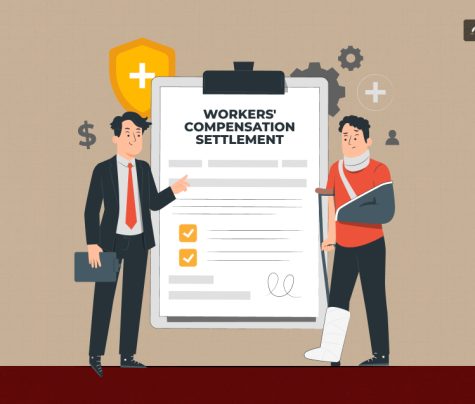
0 Reply
No comments yet.